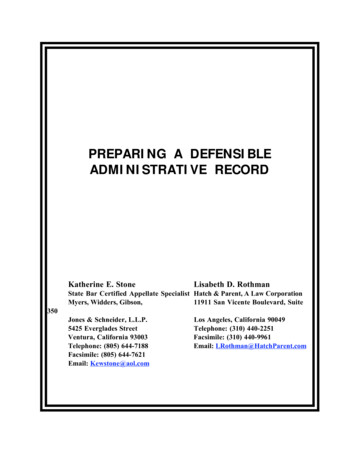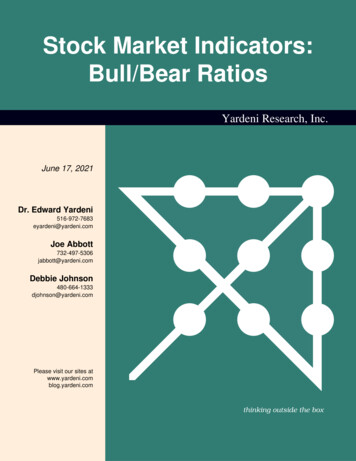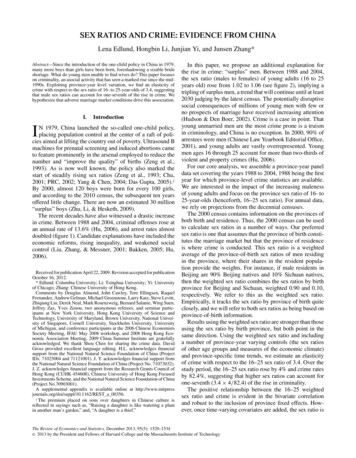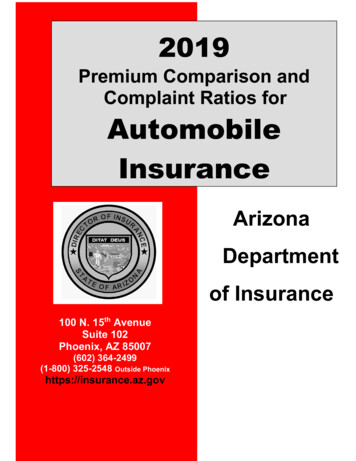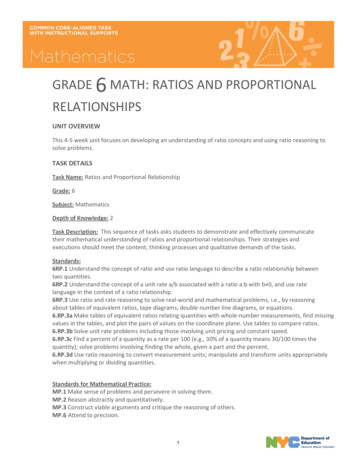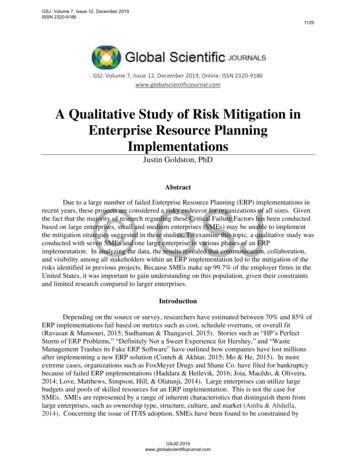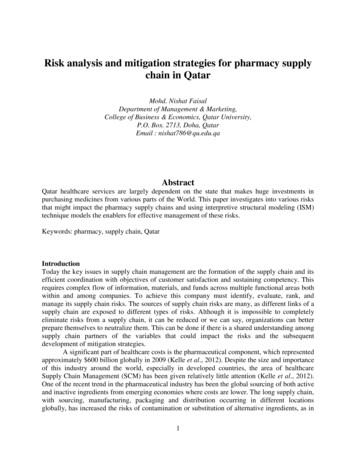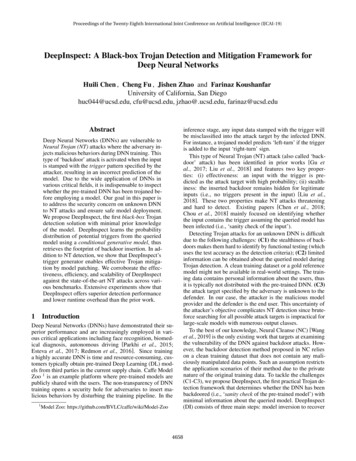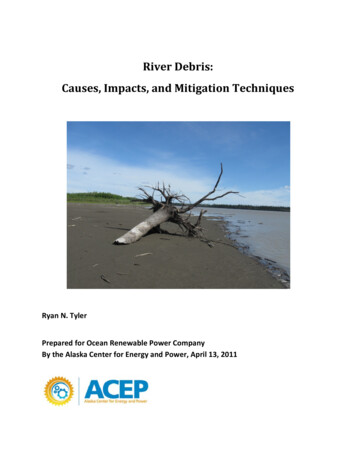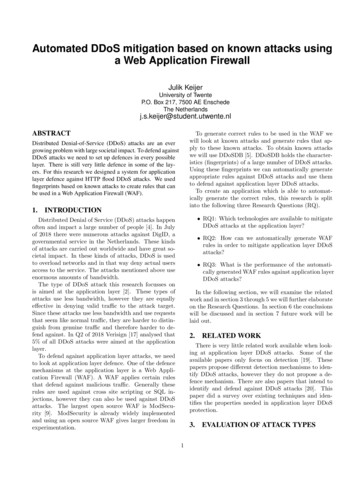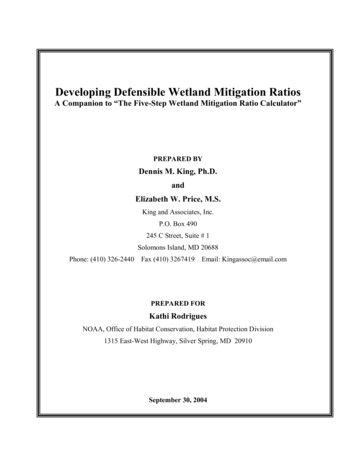
Transcription
Developing Defensible Wetland Mitigation RatiosA Companion to “The Five-Step Wetland Mitigation Ratio Calculator”PREPARED BYDennis M. King, Ph.D.andElizabeth W. Price, M.S.King and Associates, Inc.P.O. Box 490245 C Street, Suite # 1Solomons Island, MD 20688Phone: (410) 326-2440Fax (410) 3267419Email: Kingassoc@email.comPREPARED FORKathi RodriguesNOAA, Office of Habitat Conservation, Habitat Protection Division1315 East-West Highway, Silver Spring, MD 20910September 30, 20041
Developing Defensible Wetland Mitigation RatiosA Companion to “The Five-Step Wetland Mitigation Ratio Calculator”Prepared byDennis M. King, Ph.D. and Elizabeth W. Price, M.S.University of Maryland, Center for Environmental SciencePrepared forKathi RodriguesNOAA, Office of Habitat Conservation, Habitat Protection Division1. INTRODUCTIONThe ProblemNOAA is asked frequently to make recommendations regarding permit applications fordevelopment projects that will adversely affect coastal wetlands. Because coastal wetlands arescarce and important to fisheries and other marine resources, and are at risk from unavoidablehazards such as sea level rise, NOAA usually recommends that these permits be denied. DespiteNOAA’s objections, however, many of these projects are permitted as long as permit-seekersagree to mitigate adverse wetland impacts by undertaking wetland creation, restoration, orenhancement projects. In these cases, the most effective fall-back strategy for NOAA is to exertas much influence as possible over the quantity and quality of wetland mitigation that isprovided to offset “unavoidable” wetland impacts.The cost of providing wetland mitigation depends on the quality of mitigation that isrequired, which is reflected in spending per acre; and the quantity of mitigation required, whichis reflected in the number of acres of mitigation required per acre of wetland impact. Asrestoration standards have evolved to improve the quality of mitigation, the economic incentivesfor permit seekers to try to hold down the quantity of mitigation required by regulators hasincreased. NOAA’s role, and the role of other resource agencies involved in managing wetlandmitigation, is to assure that the stronger economic incentives that permit seekers and mitigationproviders have to control costs do not result in wetland mitigation that fails to replace lostwetland functions and services. However, in the absence of technically and legally defensiblemethods for comparing the functions and values of impacted wetlands with those frommitigation wetlands, it is difficult for NOAA to play its essential role of imposing quality controlon wetland mitigation.This paper describes an analytical tool that can be used to develop wetland mitigationratios that are technically and legally defensible, and are based on achieving “full” replacementof lost wetland services. The tool can be used to establish appropriate ratios for specific wetlandpermitting decisions, to “score” wetland mitigation trades, or to assign “credits” to wetlandmitigation banks. Using the tool, in most cases, will result in higher mitigation requirementsthan not using the tool. Using the tool also provides economic incentives for developers to avoid2
and minimize wetland impacts. Because the tool links the quantity of mitigation required(number of acres) to the quality of mitigation offered (gains in wetland services per acre), it alsoprovides economic incentives for developers who cannot avoid wetland impacts to invest inhigher quality wetland restoration.The Policy ContextMost state and federal wetland policies involve a three stage process known as“sequencing” which requires wetland permit seekers to: avoid wetland impacts if possible,minimize unavoidable wetland impacts to the maximum extent “practicable”, and mitigate anyremaining wetland impacts. In principle this approach makes sense (MOA, 1990). The costsand delays associated with the third stage of permitting, wetland mitigation, provide at leastsome economic incentives for land developers to avoid and minimize wetland impacts. And, aslong as wetland mitigation actually offsets unavoidable wetland losses, the approach results in“no net loss” of wetlands without preventing worthwhile coastal economic development thatreally cannot be designed to fully avoid wetlands.Use of Economic AnalysisNOAA can use economic analysis to provide more protection for wetlands during thefirst two stages of sequencing by more carefully scrutinizing the documentation that permitseekers provide to permitting agencies to show that they are avoiding and minimizing wetlandimpacts. However, undeveloped coastal lands in most areas are so scarce that developers whoapply for wetland permits probably have exhausted their options to avoid and minimize wetlandimpacts, and can prove it. Other than stopping potentially worthwhile economic development orpublic works projects that result in “unavoidable” wetland impacts, therefore, the only option forNOAA and other regulatory agencies is to allow these projects with acceptable mitigation. So, itis often during the third stage of sequencing, when permit seekers are arranging to providemitigation for unavoidable wetland impacts, that NOAA can most usefully apply economics tohelp prevent losses of wetland functions, services, and values. Where opposing a proposedwetland development project cannot succeed, in other words, the next-best strategy for NOAA toprotect wetland services is to impose quality control on the wetland mitigation associated withthe project.After describing the policy context of wetland mitigation and the challenges it poses towetland regulators, this paper describes and illustrates a technically and legally defensibleapproach that NOAA field staff can use to impose quality on wetland mitigation. The paper is acompanion to “The Five-Step Wetland Mitigation Ratio Calculator” which is a spreadsheetbased tool for applying the approach.Mitigation ContextWetland mitigation is a sound idea and there are many specific examples of wetlandimpacts that have been successfully mitigated. However, virtually every review of wetlandmitigation over the past twenty years has shown that overall wetland gains resulting frommitigation projects have not adequately offset overall wetland losses that are resulting frompermitted wetland development (NRC 2001, OPPAGA 2001, King 1997). According to thesereviews the problems with wetland mitigation fall into two categories: 1) the number of acres ofwetlands provided as mitigation is less than the number of wetland acres impacted; and 2) where3
mitigation does result in at least “one-for-one replacement” in terms of wetland acres,differences in wetland quality between the lost and replacement wetlands result in a net loss ofwetland functions and services.Our national wetland mitigation policy is logical, in other words, on both economic andenvironmental grounds; but it is apparently being implemented in a way that is resulting in asteady loss of valuable and often irreplaceable wetlands. In terms of wetland services, if not interms of wetland area, this policy, as it is currently being applied, is failing to achieve ournational goal of “no net loss.”Source of the ProblemWetland experts often attribute the problems with wetland mitigation to our limitedunderstanding of wetland restoration science and technology and our inability to measure andcompare the value of wetlands. The argument here is that wetland mitigation is failing becausewe do not know how to create or restore wetlands and cannot measure what is important aboutthem. However, most reviews of wetland mitigation failures indicate that this is probably asecondary issue, and that mitigation fails most often because wetland mitigation projects werenot designed to succeed, were not implemented properly, or were located where site conditionsor landscape factors prevented them from succeeding. While there are limits to restorationscience and technology that will always limit mitigation success, the evidence indicates that thereal problem is not these limits, but perverse economic incentives in wetland mitigation markets.Mitigation providers have strong economic incentives to lower permitting costs by providing thelowest quality mitigation that wetland regulators will allow; and mitigation regulators do nothave the tools they need to impose quality control on mitigation or to provide countervailingeconomic incentives that promote high quality mitigation.Measuring Mitigation SuccessNormal markets are more or less self-regulating as buyers and sellers compete with eachother over price and quantity. Wetland mitigation markets, however, are very different. Sellersof mitigation (e.g., mitigation contractors and, more recently, mitigation bankers) and buyers ofmitigation (e.g., real estate developers, state DOTs) actually have more economic incentives towork together to keep mitigation costs low than they have to compete with one another. Bothbuyers and sellers of mitigation tend to be only as concerned about mitigation quality asmitigation regulators or the rules governing mitigation require them to be. In this marketsituation the high level of confusion and uncertainty about the relative “value” of different typesof wetlands (e.g., restored vs. natural, urban vs. rural, tidal vs. non-tidal, vegetated vs. mud) is anadvantage to those interested in controlling permitting costs and has contributed to widespreadmitigation failure. Uncertainty about wetland values has made it nearly impossible forregulatory agencies to use conventional economic arguments to justify imposing quality controlon wetland mitigation. It has also made it difficult for resource agencies to argue that any acreof wetland creation, restoration, or enhancement that is offered as mitigation is worth any lessthan the acre of natural wetland it is supposed to offset.Worsening this problem is the fact that in most regulatory and judicial settings the burdenof proof is not on permit-seekers to demonstrate that one-for-one wetland mitigation will resultin no net loss of wetland services, but on the wetland regulators to show that proposals that4
involve one-for one mitigation will result in losses in wetland functions and values. The “valuefree” bio-physical indicators of wetland function that are preferred by wetland scientists may beuseful for making certain wetland comparisons, but they have not been useful as a legitimatebasis for determining the adequacy of mitigation, establishing how much money permit-seekersshould spend on mitigation, or deciding how liability for mitigation failures should be assignedto buyers or sellers.Underlying the high failure rates associated with wetland mitigation is another economicreality that buyers and sellers of wetland mitigation and most regulators understand. The cost ofwetland restoration projects that have a reasonable chance of providing wetland services that are“equivalent” to those that are lost when a natural wetland is lost can be enormous, and are oftenprohibitive. None of the groups involved with wetland mitigation want standards that are sostrict that they will close out the option of using mitigation to resolve wetland permittingproblems. As long as the standards for what constitutes acceptable mitigation are kept vague, onthe other hand, it is possible to control mitigation costs, and claim to be achieving the national“no net loss” wetland goal without anticipating any technical or legal challenges.In summary, the root source of the problem with our national wetland mitigation policy isthat the rules governing mitigation trading have evolved primarily to keep the cost of mitigationaffordable and to make our national wetland policy appear to be successful. Tools that helpinsure that wetland gains from mitigation actually offset wetland losses are not available, and arenot popular with mitigation traders or with many wetland regulators. Despite protests to thecontrary, the powerful interests involved in wetland mitigation prefer using ad hoc (political)negotiations over what constitutes acceptable mitigation to strict (accounting-based) tradingrules. If trade regulators had the political support and technical tools to negotiate effectively thiswould be an acceptable situation, but they do not. This is why formula-based mitigation tradingrules like the one developed later in this paper are so important.Proposed SolutionUltimately debates over wetland values and the “equivalency” of wetland gains andlosses from mitigation are usually reduced to establishing a “compensation ratio”, a number thatestablishes the number of mitigation acres required per acre of wetland impacts. The implicitquantity/quality tradeoff inherent in the use of compensation ratios strikes some as illogical (e.g.,how many acres of created mudflats are equivalent to an acre of mature mangrove?). However,if the compensation ratio is developed in a way that compares gains and losses in expectedstreams of wetland services it can be used effectively to both protect wetlands and managewetland mitigation. For example, using conventional methods of dealing with differences in thetiming and riskiness of wetland services provided by lost and replacement wetlands, it isrelatively easy to establish that many acres of a young, restored wetland will be needed toprovide the equivalent “value” of an acre of mature, natural wetland. Such a comparison, ineconomic terms, is not much different than comparing how many shares in a risky start-upcompany (e.g., a penny stock) would be equal, in terms of expected earnings over time, to ashare in a mature, proven company (e.g., a blue chip stock).The approach to establishing wetland mitigation ratios that is described here and can bemade operational using “the five-step wetland mitigation ratio calculator” is based on theuniversal “net present value” approach to asset valuation. This approach is used routinely to5
compare the values of all kinds of manufactured assets and financial assets, and has withstoodcountless technical and legal challenges for at least a century. The approach provides a credible,practical, and defensible way for NOAA to impose quality control on wetland mitigation. Thespreadsheet tool for applying the approach is easy to use and focuses attention on a few keycharacteristics about the impacted wetland and the replacement or mitigation wetland thatdetermine the relative “value” of the streams of wetland services they are expected to provideover time.Applications of the ToolThe tool requires users to set numerical values for eight parameters associated withimpacted and the mitigation wetlands. These values can be generated in many different ways,but the most likely approach will involve expert consensus. Once these parameters aredetermined, the tool can be used in one of three ways: 1) to establish compensation ratios for aparticular mitigation proposal or trade, 2) to establish the number of credits associated with“consolidated” mitigation projects or mitigation banking ventures, and 3) to influence theoutcome of ad hoc negotiations over what constitutes acceptable wetland mitigation. Becausethe approach establishes the quantity of mitigation required (acres) on the basis of the quality ofthe mitigation provided (expected service flows per acre) it also provides incentives formitigation providers to improve the quality of the wetland mitigation they provide in order toreduce the quantity of mitigation they will be required to provide.Format of PaperThe remainder of the paper contains sections that: describe the economic basis forestablishing mitigation ratios; define some key variables; and present and illustrate the use of a“universal” wetland mitigation ratio estimating equation. The main body of the paper is thenfollowed by Appendix A, a four-page print-out from an interactive spreadsheet program called“the five-step wetland mitigation ratio calculator”; Appendix B, The effects of time discountingon the estimation of mitigation ratios; Appendix C, the effects of landscape context on theestimation of mitigation ratios; and Appendix D, a list and set of references for over 50 WetlandAssessment Methods that can be used with “the five-step wetland mitigation ratio calculator”.Information for determining which wetland assessment method is most suitable under particularcircumstances is beyond the scope of this paper, but interested readers should consult Bartoldus(1999).2. BACKGROUNDEconomic Basis of Mitigation RatiosDifferences in a wetland’s condition and location can result in significant differences inthe functions, services, and values it provides; an immature wetland also provides fewerecosystem services than an older mature wetland. To account for these differences in wetlandquality, most wetland regulatory institutions use mitigation ratios to adjust the number of acresgained and lost as a result of mitigation trades. This ratio is calculated as the number of acres ofcreated, restored or enhanced wetlands required as mitigation for each acre of natural wetlandbeing impacted.6
From an economic perspective these ratios reflect a type of quantity-quality tradeoff.Where two assets involved in a trade are of equal value, whether they are wetlands or financialinstruments, they can be fairly traded on a one-for-one basis. Where they are not of equal value,some type of quality/quantity adjustment is typically used to even out the trade. In principle, themitigation ratio is intended to balance gains and losses since the wetland functions and servicesassociated with an acre of created or restored wetland are usually expected to be less than thoseassociated with a natural (impacted) wetland. Of course, in cases where the impacted wetland isalready severely degraded or is in an inferior location it is reasonable to expect that theappropriate compensation ratio could be less than one-for-one.In general, the mitigation ratio is supposed to be an aggregate index that allows thequantity of wetlands gained and lost to be adjusted to account for differences in wetland qualitythat result in differences in the streams of ecosystem services they are expected to provide overtime.The Use of Mitigation RatiosA national review of 68 wetland mitigation banks (Brown and Lant, 1999) determinedthat the mean mitigation ratio used to score wetland mitigation trades in the U.S. was 1.36:1,based on the number of trades, and 1.41:1 when trades were weighted by wetland area. That isroughly 1.4 acres of created or restored wetland for each acre of natural wetland destroyed. Thereview also showed that “the majority of wetland mitigation banks use a 1:1 ratio, accounting for73% of all the acreage.”One-to-one is a surprisingly low “typical” compensation ratio, especially considering thatthe sample of mitigation projects used in the study had the following characteristics: creation(25%), restoration (49%), enhancement (15%), preservation (12%)1. Wetland restorationprojects are inherently risky, and it takes time for even successful wetland restoration projects toachieve full functional capacity. Also, providers of mitigation are not expected to receive“credit” for wetland functions that exist at the mitigation site prior to mitigation. If these factorswere considered, one would expect to almost never encounter a mitigation ratio of 1:1. In fact,using an economic approach to establishing mitigation ratios based on asset values, such as theone described and illustrated below, a ratio of 1:1 can only result in “no net loss” of wetlandfunction and value in the unlikely event that each acre of proposed mitigation provides full,immediate, and riskless replacement of all wetland services provided by each acre of impactedwetland.One reason that prevailing compensation ratios are inconsistent with asset-based tradingis that wetland scientists and environmental protection advocates have generally viewed allwetlands as valuable, and have
national goal of “no net loss.” Source of the Problem Wetland experts often attribute the problems with wetland mitigation to our limited understanding of wetland restoration science and technology and our inability to measure and compare the value of we
